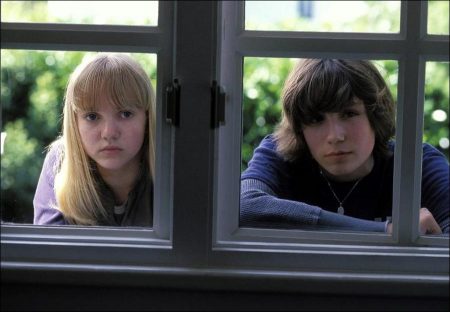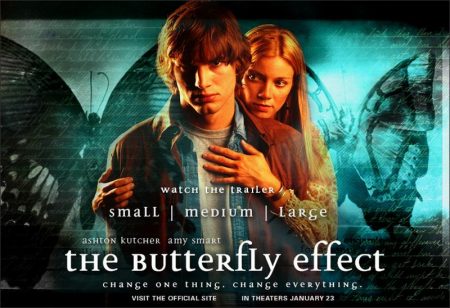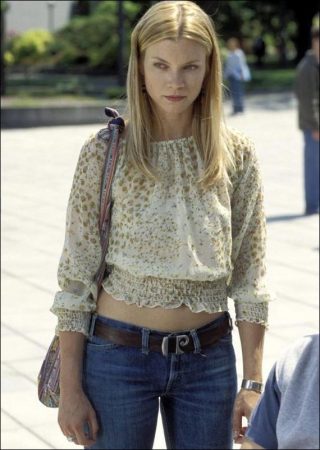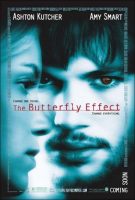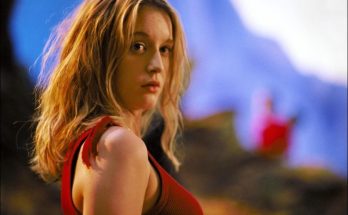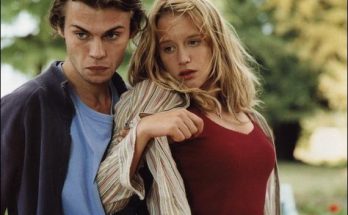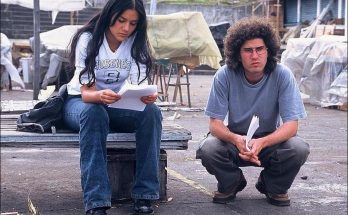Ashton Kutcher, who made the leap from the highly rated comedy series “That ’70s Show” to films like Dude Where’s My Car and Just Married, stars as Evan Treborn, who is haunted by suppressed memories of a deeply troubled past. “Evan is a guy who doesn’t know who he is,” Kutcher explains. “He has blacked out all the traumatic moments in his life, and through the course of the movie, he discovers that he doesn’t necessarily like who he is.”
One saving grace throughout his life has been Kayleigh Miller (Amy Smart), a childhood sweetheart who now as an adult finds herself equally lost. “Kayleigh has always been in love with Evan, since she was young,” says Smart, who has starred in such films as Varsity Blues and Road Trip and will next be seen in Starsky & Hutch. “She grows up to be a lonely girl who works in a diner and hasn’t gone on with her life. She has stayed in the town she grew up in to be closer to Evan.”
Driven by his own personal demons, Evan discovers old journals that he kept during one of the darkest periods of his childhood ‘ a period woven with blackouts in which Evan doesn’t remember anything. But by reading these journals, something remarkable happens ‘ he finds that he has the ability to go back and inhabit his childhood body. “If you woke up tomorrow and you could live your life again in a completely different way, would you do it'” asks Kutcher. The trigger, says Kutcher, is when he realizes that his childhood sweetheart, Kayleigh, still loves him. “He decides to go back to his childhood and from there, create a world where everyone he cares about, most importantly Kayleigh, is happy.”
Once back in his childhood body, Evan must come face to face with the demons of his past. “We’re dealing with some pretty dark deeds – some of the horrible things that human beings do to one another,” comments co-writer/director Eric Bress. Co-writer / director J. Mackye Gruber feels that the story plugs in to a universal desire among human beings. “Everybody, whether they admit it or not, has a day in their life that they would love to live over,” says Gruber. “This movie poses some interesting questions about the effects of our actions ‘ in both the past and the present.”
Each time Evan goes into the past, he comes back to some drastic changes in the present. “At the beginning of the film, Evan thinks that he’s going crazy,” says Kutcher. “He’s not crazy, but the anticipation is pushing him in that direction. Evan is constantly waking up and wondering ‘where the hell am I and who are these people””
Similarly, each time Evan goes into the past, the difference in Kayleigh’s life is wildly divergent, transforming her from a waitress to a sorority girl to a drug addict. Despite these changes, Amy Smart worked to keep the through-line of Kayleigh true to the character. “This is a dream role,” says Smart. “I play a character at four different stages, but all within the context of the same girl.”
While the mutual but unspoken love between Evan and Kayleigh continues throughout each incarnation, Kutcher points out the two actors kept it balanced on a fine line. “The consistent thread through all of the alternate realities is our undying love for each other,” the actor comments. “In fact, the first thing that triggers Evan to go back and try to change things is that he finds out Kayleigh still cares for him. But in some scenes we despise each other. We think that one has left the other for dead and doesn’t care ‘ and yet we both care. It’s a bizarre mix of not wanting to show the person that you’ve been hurt or that you still love her, no matter what happens.”
Though Kutcher has previously been known mostly as a comic actor, he relished the opportunity to take on more serious material. “I’ve always been interested in playing real people and doing dramatic roles. I just haven’t had the opportunity until now,” he comments. To prepare for his role, Kutcher studied psychology, particularly cases of people with disassociation disorder, which causes them to black out traumatic memories. “I was interested in trying to learn what causes people to go into these remissive states where they try to hide their feelings in order to avoid having to confront them, which is similar to what Evan does,” says the actor.
Co-star Amy Smart feels the cast has been on a “great journey, because we’re constantly on this roller coaster ride of different emotions and different places, trying to keep up with the intertwining of past and present. We’re working off each other and really trusting each other to go to whatever extreme levels we want to and feeling open about it.”
Rounding out Evan’s childhood circle are Lenny (Elden Henson) and Kayleigh’s brother, Tommy (William Lee Scott). “Lenny is Evan’s best friend,” describes Henson. “He’s the guy who was pushed around and bullied all his life and takes a crazy journey through various mental illnesses.”
Henson shot all of his scenes in reverse order and had to lose 20 lbs. to play Lenny as he appears at the end of the film. “I spent three and a half hours a day working out at the gym and eating like a rabbit,” says Henson. He then had three weeks to gain those 20 lbs. back. “That was a pleasure ‘ lots of chocolate chip pancakes, donuts and beer,” Henson chuckles. “Maybe not the healthiest diet, but the results will look really cool.”
Tommy, conversely, takes out his rage over his troubled home life on Lenny and Evan. “We live pretty traumatized lives,” notes William Lee Scott. “And then I play the adult version of the traumatized child and all the different versions as we all experience the “Butterfly Effect’ of Evan’s journeys.”
“The Butterfly Effect,” explains Amy Smart, is “the theory that when a butterfly flaps its wings, say, in New York, it’s eventually felt in Japan as a hurricane. In the film, this theory is demonstrated by how Evan goes back into his past and changes something small, but it affects everything in the present moment. Each time he goes back, he’s changing a little more of this troubled childhood that he grew up in, often for the better, but just as often for the worse.”
Co-writers/directors Eric Bress and J. Mackye Gruber were constantly attuned to the performance of each actor as he or she played the same character at different stages. “It’s been a lot more challenging than I think any of us could have anticipated,” says producer Chris Bender. “We have twelve actors playing four roles in three different time periods.” “The odds were against us, but somehow the casting gods were smiling on us,” comments J. Mackye Gruber. “All of the actors are so talented.”
Rounding out the cast are Melora Walters as Evan’s mother, Andrea Treborn, and Eric Stoltz as Mr. Miller, Kayleigh’s abusive father. “In casting Mr. Miller, we wanted the ‘guy next door,'” says Eric Bress. Stoltz, a veteran actor of such films as The Rules of Attraction, Pulp Fiction and Mask, was drawn not only to the multi-layered script, but the passion of Bress and Gruber to tell this story. “I love working with people who are passionate and possessed ‘ who really care,” he comments. “That’s what these guys are. They also have a wonderfully economic way of dividing, but handling all the problems that flare up. It’s unusual but it’s fun.”
Co-writers/directors Bress and Gruber realize their filmmaking technique may seem unorthodox, but in this case it actually worked to the advantage of the film’s intricate plot. “We’ve been working together for nine years now, six of them on this project,” he says. “We know each other very well and there is a high level of trust. There are a lot of details to keep track of in this film and in this case, two minds are better than one.”
“These guys are amazing to work with,” Ashton Kutcher enthuses. “They can justify every movement, every line in the script. They know it intimately. They’re also very open. They respect my acting choices and are willing to consider anything we might suggest.”
Gruber and Bress wrote the screenplay for The Butterfly Effect seven years ago. Marrying the supernatural with gritty realism is a technique that Bress and Gruber have found gives them a great deal of latitude in dealing with challenging subject matter. “Anytime you have the supernatural in a movie, to me, there are three ways to go: you get bitten by a radioactive spider; your dad works at a science lab where you steal the pocket-watch out of his briefcase; or you’re born with it in an inexplicable sixth-sense kind of way. The last one’s the way we went,” Bress explains.
“Because it delves into the realm of the supernatural, one might think that the story is fantastical. Exactly the opposite,” says Gruber. “Every character and nuance comes from our hearts. It’s very personal stuff.”
Producers Chris Bender and JC Spink, through their management and production company Benderspink, first read the screenplay six years ago. “JC and I originally read the script as a writing sample and quickly signed Gruber and Bress to our management company,” Bender explains. Bender and Spink shopped the spec script at that time. “Production companies around town thought it was one of the most provocative scripts they’d ever read ‘ they loved it, but there was a definite fear factor,” Bender recalls.
Benderspink teamed up with FilmEngine, a production company formed in 2001 to acquire, develop and fully finance films in-house, and New Line Cinema to secure a green light. “The Butterfly Effect was first and foremost a page-turner, a script that you just couldn’t put down,” says producer AJ Dix of FilmEngine. Following their work on the screenplay for Final Destination 2, Eric Bress and J. Mackye Gruber pursued their long-held dream of directing The Butterfly Effect themselves. “Gruber and Bress received many offers to sell the script, but this project was their baby,” says Dix. “They were passionate about directing the film to preserve the integrity of the story.”
Because the film explores several alternate realities, each one engendered by Evan’s time travel, immaculate attention to detail was required to ensure continuity and create believable sequences and transitions. “After living with the film for six years, I don’t even have to look at the page,” says Gruber. “I know the whole maze ‘ the shooting style for each alternate reality. It’s like a big jig-saw puzzle.” “Not to mention the product of hundreds of discussions concerning every detail,” adds Bress.
“There are some very nicely designed transitions that the directors have taken an imaginative approach to and put a lot of thought and pre-planning into,” says editor Peter Amundson. “This film takes us on an interior, psychological ride rather than being manifested visually all of the time. For me this requires more attention in the editing to the weight of a sequence, the pitch of the performance, the levels in an emotional arc ‘ in other words, the story and the characters. It’s a nice change from making the cuts faster like in many films.”
To create a different visual palette for each of the film’s alternate realities, the filmmakers brought in veteran director of photography Matthew F. Leonetti. “We used every kind of stock that Kodak makes to signal the reality shifts,” Leonetti says. “Some of our lighting set-ups have been of the classic black-and-white, film noir genre, even though we’re using color stock. We also washed-out certain sequences in the printing process to give them a blue hue. There’s a lot of hand-held work, tilting cameras, some high shutter speed sequences and low light level shots. This approach is meant to be psychological and subtle.”
Production began in Vancouver, British Columbia in June 2002 and continued for eight weeks in diverse locations around the city, including Riverview Hospital, the University of British Columbia campus and Edith Cavell Elementary School.
For the alternate reality sequence in which Evan wakes up to find himself incarcerated, a splinter crew traveled to Monroe Corrective Complex, a maximum-security prison in Washington State. “We had over 100 extras who were actual inmates,” J. Mackye Gruber describes. “Most of them were serving life sentences. We also had some inmates from Death Row. I was looking for a guy to be on the bus in one scene, and had a guy in mind, but someone said ‘That’s the one who killed 10 people ‘ I don’t know if he should be on the bus!’ Another time, this big guy came up to me and said, ‘so what’s my motivation, man'”
For Kutcher, the ultimate blessing to make a film that covers some of the dark territory The Butterfly Effect explores is his mother’s approval. “I will never do a movie that my mom wouldn’t go to see and be proud of me for doing it,” Kutcher says. “I wasn’t sure about this one, so I gave her the script to read. She was disturbed by it, but ultimately found it worthwhile. She said, “You’re showing people the truth. You’re not hiding it or candy-coating it. It’s honest. ”
“I think the greatest thrill of my life is going to be watching that first audience,” says co-writer/director Eric Bress. “What we’ve always said about this movie is that we can’t wait to be in the lobby listening as everyone walks out of the theatre’hopefully saying ‘Don’t talk to me ‘ I’ve got to try and figure this out!”
The Butterfly Effect (2004)
Directed by: Eric Bress, Jonathan Mackye Gruber
Starring: Ashton Kutcher, Amy Smart, Elden Henson, Eric Stoltz, Melora Walters, Irina Gorovaia, Kevin G. Schmidt, Logan Lerman, Cameron Bright, Ethan Suplee
Screenplay by: Eric Bress
Production Design by: Douglas Higgins
Cinematography by: Matthew F. Leonetti
Film Editing by: Peter Amundson
Costume Design by: Carla Hetland
Set Decoration by: Sam Higgins
Art Direction by: Shannon Grover, Jeremy Stanbridge
Music by: Mike Suby
MPAA Rating: R for violence, sexual content, language and brief drug use.
Distributed by: New Line Cinema
Release Date: January 23, 2004
Visits: 232
